Apple iPad mini with Retina Display: Reviewed
by Anand Lal Shimpi on November 16, 2013 8:00 AM ESTThe Display
The big story behind the new iPad mini is of course its 7.85-inch Retina Display. We’re talking about the same 2048 x 1536 resolution as the iPad Air, but in a much smaller form factor. The result is the highest pixel density of any Apple display ships today, tying with the iPhone 5S. The impact on the overall experience is pretty significant. Text is obviously a lot sharper, but even graphics are a lot nicer to look at on the new Retina Display. The gains aren't quite as obvious as they were on the larger iPad, but after living with the Retina mini for a while I can't easily go back to the previous version.

iPad mini (left) vs. iPad mini with Retina Display (right)
I ran Marco Arment's image retention test on the Retina mini and didn't see even the slightest degree of image retention. My old, non-Retina iPad mini on the other hand exhibited image retention. I suspect Apple is multi-sourcing its displays here, which could obviously contribute to varied behavior. At least on the two minis I have, image retention isn't an issue.
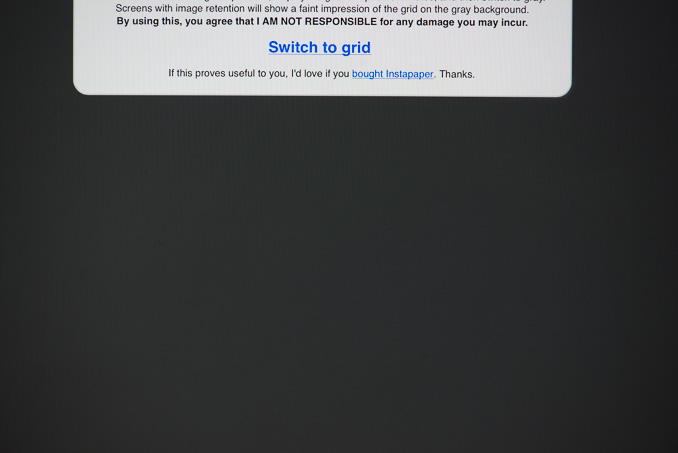
In the conclusion of my iPad Air review I wrote about the new mini as finally being a no-compromises smaller iPad. Much like my assertions last year of a Retina mini not being in the cards, it turns out that I was wrong on this point as well. Although display resolution is no longer a concern on the mini, color gamut hasn’t changed between the old and new minis. A quick look at our gamut test gives us an idea of what’s going on:

The iPad mini with Retina Display has the same color gamut as the standard iPad mini, which is narrower than the iPad Air and less than the sRGB coverage we normally look for. The biggest issue here is that there are other smaller tablets in this price range that do offer sRGB coverage (e.g. Nexus 7, Kindle Fire HDX 8.9).
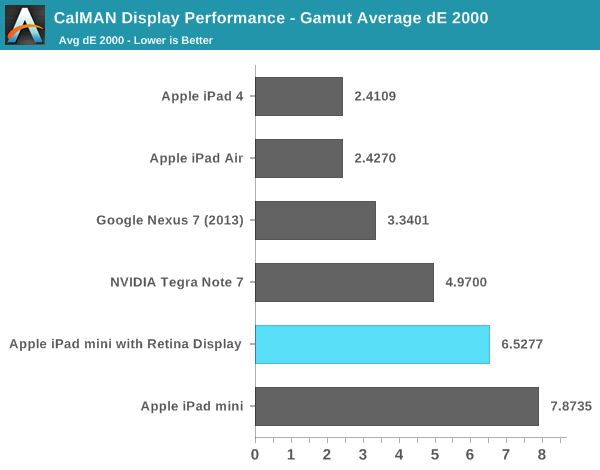
I suspect the justification here is Apple likely views the bigger iPad as being a better fit for photographers/those who care about color reproduction, but it’s a shame that this is a tradeoff that exists between the two iPads especially given how good Apple is about sRGB coverage in nearly all of its other displays.
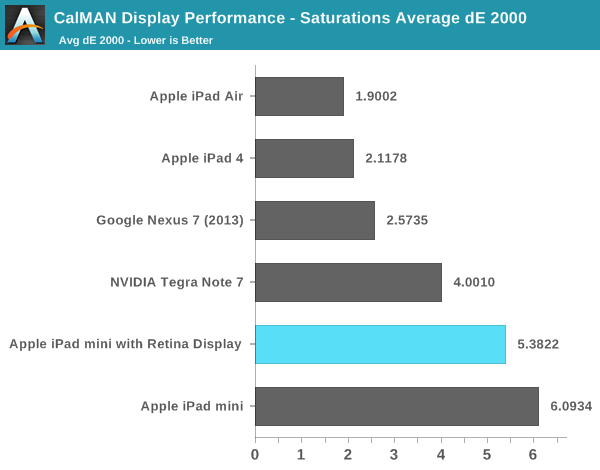

One of the simplest visual tests is to use one of iOS 7’s more colorful wallpapers and compare the Retina mini and iPad Air side by side:
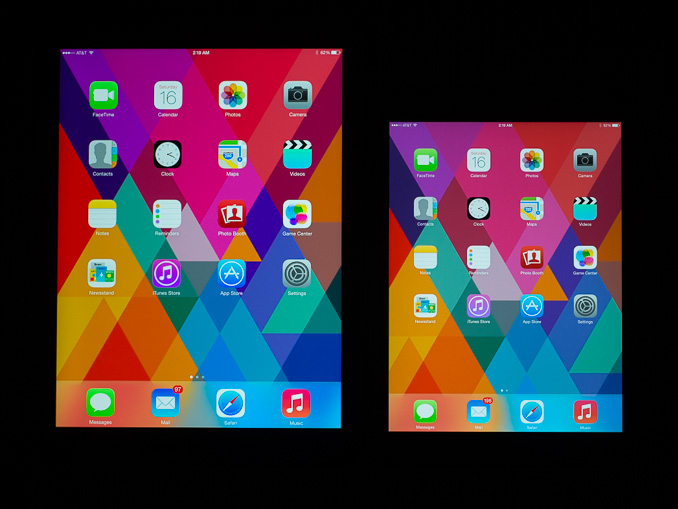
Pay attention to the color of the red triangles in the lower left
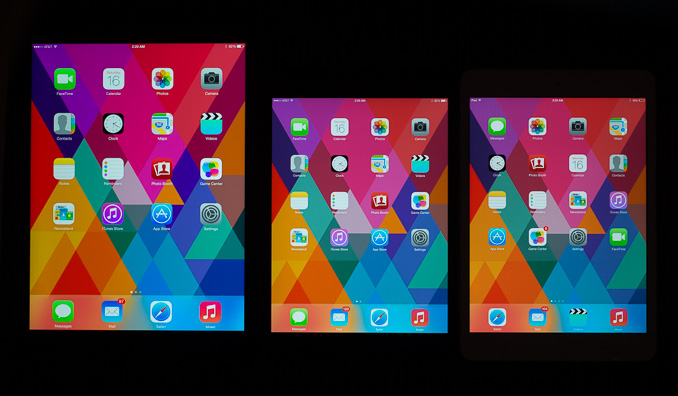
From left to right: iPad Air, iPad mini with Retina Display, iPad mini
The difference is small but apparent, particularly if you’re used to panels with full sRGB coverage like the iPad Air or any of the rMBPs/iMacs. The biggest deviations are in reds/blues and magenta in between as you can tell from the CIE chart above.

Within its gamut coverage, the mini’s panel is fairly accurate. A look at our GMB checker test shows performance competitive with the Nexus 7 and not far off the 4th generation iPad. Grayscale reproduction is also quite good. The display looks really good otherwise, but you don’t get the same visual punch you do on the iPad Air.
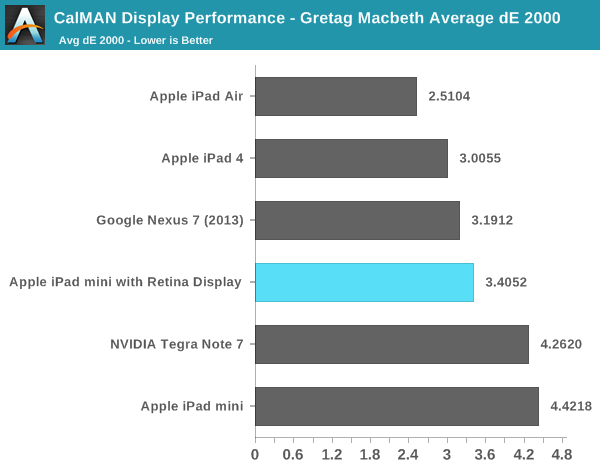

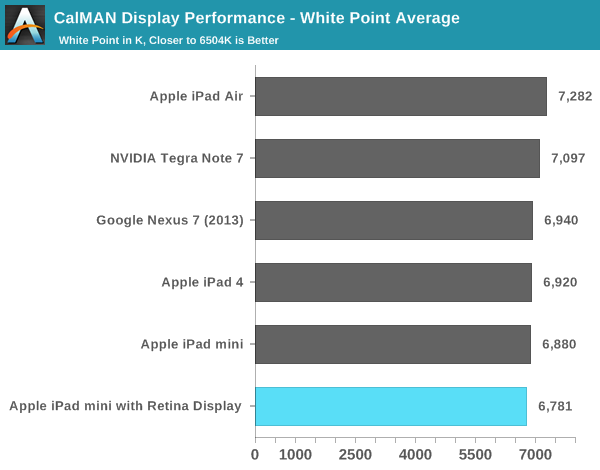
Compared to the previous generation mini we’re obviously talking about a much better panel. But for those of you on the fence between the mini and Air, the Air does still hold a display advantage.
Black levels are competitive and contrast ratio stays fixed at around 800:1 regardless of whether we’re talking about max brightness or the 200 nits we run all of our battery life tests at. Max brightness is down a bit compared to the iPad Air.
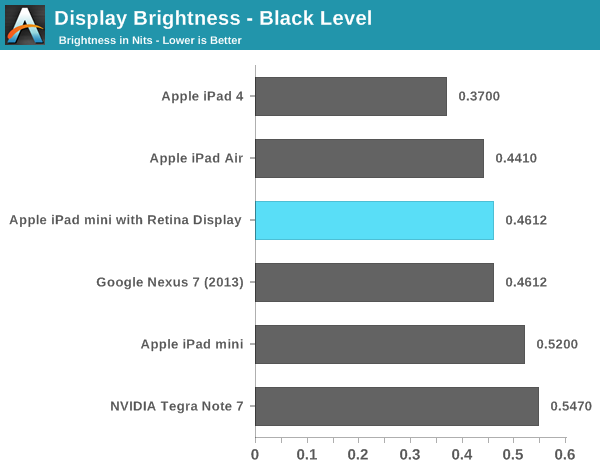
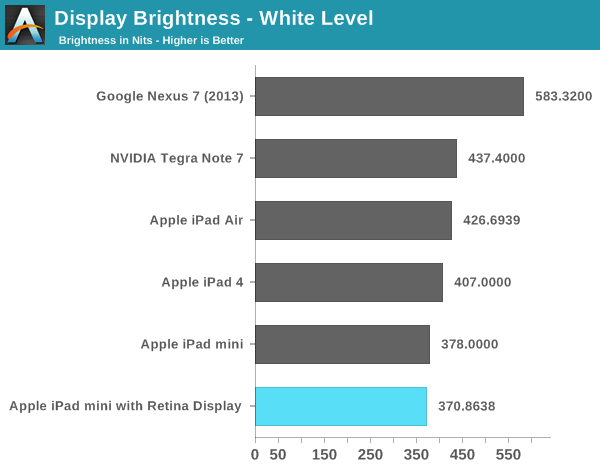
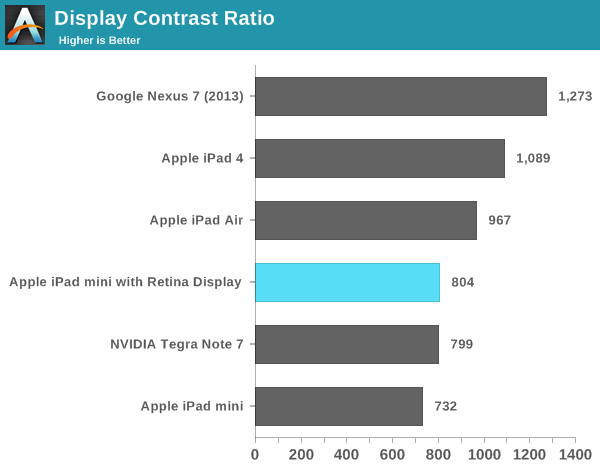










345 Comments
View All Comments
solipsism - Saturday, November 16, 2013 - link
Or you can save $100 by going with a smaller capacity device. Apple will make their margins regardless so what you're really saying is that they should 1) not make the iPad Mini only start at $299 and 2) they shouldn't even offer the lower capacity options because at $5 increments for doubling of capacity (laughable) it's only $15 between 16GB and 128GB.The fact is companies determine the entire line to figure how to maximize sales, margins and profits, not just an individual model, which is something you should understand even if you haven't taken a single economics course.
kyuu - Saturday, November 16, 2013 - link
Why the hell should the end consumer care about that? $100 for $5 worth of NAND is a rip-off. The end. Nobody cares about the ways in which Apple seeks to pad their already absurd profit margins.And yes, they could very well move their base model up to 32GB, like a lot of the rest of the market.
solipsism - Saturday, November 16, 2013 - link
The consumer (not sure why included the word "end" in there) should buy the product that best fits their needs. The consumer shouldn't say "Hey, cheap NAND is only $5 for 16GB so I shouldn't have to pay anymore for faster and/or reliable NAND that is included as part of a vendor's product."What you have done is foolishly expect that capacity should be sold to you at cost without any other consideration, the most egregious of which is thinking the price points should be defined by *you* and not the vendor.
People like you sicken me. You think it's up to you to dictate the terms of another company. You care nothing for the free market. You actually wrote, "Nobody cares about the ways in which Apple…" without once considering that Apple cares about their profits and that it's their product which gives the right to sell it as they see fit, yet instead of saying, "This isn't the product for me." you instead think they owe you something when they can't even keep them in stock.
It's their product and their price points. If you don't like it, don't buy it. It's really that simple.
Puberticus - Saturday, November 16, 2013 - link
Yep. You did it in a nutshell. The poor guy definitely needs a pinch.kwrzesien - Monday, November 18, 2013 - link
I think our perception of a premium product being obsolete because it fills up 16GB of NAND is important to Apple if they want to keep being a premium product. It not only frustrates users but it limits the sale of the content (apps/music/video) that consumes that space. Don't they want it to just work? Nevermind needing over 3GB free to update the OS.Daniel Egger - Saturday, November 16, 2013 - link
Why pay $3000 for a better engine in the car when the production costs are roughly the same?kyuu - Saturday, November 16, 2013 - link
I wouldn't. Generally, better engines do in fact cost more to produce, though, and generally there are more differences between two models of car than just their engine.RadarTheKat - Monday, November 18, 2013 - link
You are reading this wrong. Can you build a 128GB tablet in your garage with the quality of an iPad? Given that even global electronics vendors like Samsung, Asus, and others can't, I doubt you can either. So at $829, the top end iPad mini with retina display, 128GB of memory, and LTE connectivity.Start with that model, which is a computing miracle compared with anything the world could produce just three years ago, and then you'll see that Apple SAVES you $100 if you're willing to take that same miracle with half the memory. LOL!
Hey, but thanks for playing!
RadarTheKat - Monday, November 18, 2013 - link
* So at $829, the top end iPad mini with retina display, 128GB of memory, and LTE connectivity is a steal!Klug4Pres - Saturday, November 16, 2013 - link
1GB RAM for a 64-bit CPU of this calibre is also an insult, and will mean that this thing will choke on many workloads. It will also mean that come IOS 8 or 9, it will likely be unuseable. Oh well, just drop another $500 on a 2GB RAM, 32GB version next year.